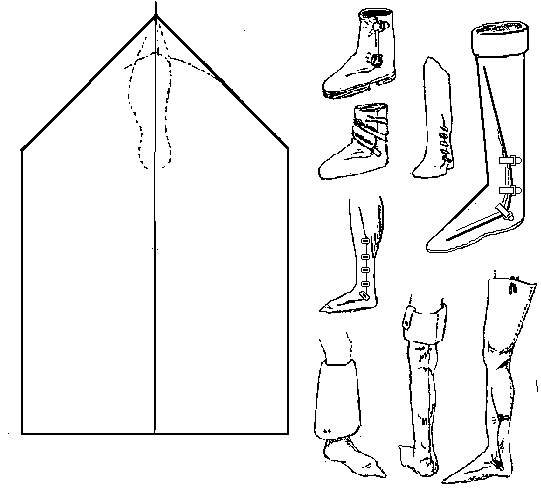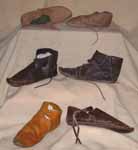Difference between revisions of "Footwear"
| Line 1: | Line 1: | ||
[[Image:SHOE27.GIF|thumb|According to the Dictionary of Costume, this style of footwear, called the Gamashe in the 17th century, is the ancestor of the military legging of later centuries. Such linen leggings are distinguishing marks of peasants and farmers for centuries. In any case, I have no evidence that it appears any earlier than the 14th century. It is a lined turned shoe, made with a rand or a full welt. The method of securing the boot appears to vary, from straps and buckles, to lacing a stretch from 10 to 12 inches along the side of the leg, even all the way up from the ankle to the knee.]] | [[Image:SHOE27.GIF|thumb|According to the Dictionary of Costume, this style of footwear, called the Gamashe in the 17th century, is the ancestor of the military legging of later centuries. Such linen leggings are distinguishing marks of peasants and farmers for centuries. In any case, I have no evidence that it appears any earlier than the 14th century. It is a lined turned shoe, made with a rand or a full welt. The method of securing the boot appears to vary, from straps and buckles, to lacing a stretch from 10 to 12 inches along the side of the leg, even all the way up from the ankle to the knee.]] | ||
| + | [[Image:Shoe1th.jpg|left]]Left, shoes made by Matthew Amt. At top are two made from the pattern below, using garment leather and sewn by machine. Middle left is a 10th century style copying an example from Durham, and next to it is a very similar 12th century type. Both have chrome-tanned leather uppers, but are hand-stitched with proper turn-shoe construction. Bottom left is a 13th century shoe fastened by two overlapping tabs with little "toggles" (short knotted thongs in this case). Bottom right is an approximation of a 14th or 15th century shoe fastened with a forked strap that passes through a pair of holes and ties. The leather and construction are not quite right, but the overall effect is decent, and it has very correct repair soles sewn on with tunnel stitches. (All of these are for the right foot.) | ||
===Links=== | ===Links=== | ||
*[http://www.personal.utulsa.edu/~marc-carlson/shoe/SHOEHOME.HTM How to make] footwear by Marc Carlson | *[http://www.personal.utulsa.edu/~marc-carlson/shoe/SHOEHOME.HTM How to make] footwear by Marc Carlson | ||
[[Category:Garb]] [[Category:Amtgard Things]] | [[Category:Garb]] [[Category:Amtgard Things]] | ||
Revision as of 23:26, 4 November 2008

Left, shoes made by Matthew Amt. At top are two made from the pattern below, using garment leather and sewn by machine. Middle left is a 10th century style copying an example from Durham, and next to it is a very similar 12th century type. Both have chrome-tanned leather uppers, but are hand-stitched with proper turn-shoe construction. Bottom left is a 13th century shoe fastened by two overlapping tabs with little "toggles" (short knotted thongs in this case). Bottom right is an approximation of a 14th or 15th century shoe fastened with a forked strap that passes through a pair of holes and ties. The leather and construction are not quite right, but the overall effect is decent, and it has very correct repair soles sewn on with tunnel stitches. (All of these are for the right foot.)
Links
- How to make footwear by Marc Carlson
